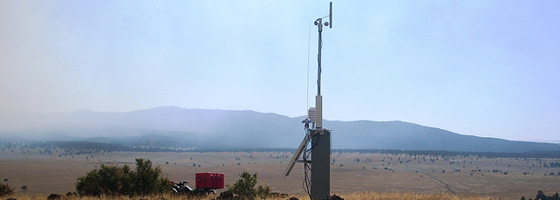Water managers support national monitoring networks, see room for improvement

In the face of an increasingly variable climate, the government agencies charged with managing the U.S. water supply will depend on funding and upgrading of the nation’s stream, snowpack and weather monitoring networks.
That’s the message expressed in a recent Climate Change and Water Working Group report focused on short-term decision making by water managers from the U.S. Army Corps of Engineers, National Oceanic and Atmospheric Administration and U.S. Department of the Interior’s Bureau of Reclamation. Managers from these agencies are responsible for flood control, reservoir management, runoff capture, ecological support, emergency response and hydropower.
The report surveyed the needs of water managers and mainly applied to government tools that support their work, including stream gauging and weather station networks.
“There was a broad appreciation for the need to sustain our networks,” said Levi Brekke, report author and water and climate research coordinator of Bureau of Reclamation’s Research and Development Office.
Brekke said that sustaining established water monitoring networks is especially important as budget squeezes threaten government research and monitoring.
Water managers from across the U.S. said they depend on established monitoring networks for modeling and forecasting.
Every water manager queried for the report uses the U.S. Geological Survey stream gauge network. Some of the gauges are close to 100 years old. “They’re really valuable resources,” Brekke said.
National Weather Service weather stations and precipitation networks were the second most used monitoring network, according to the report. Variable weather conditions, especially of late, play an important role in water managers decisions. Authors repeatedly acknowledged the uncertainty tied to managing U.S. water resources.
The report also calls for a sustained snowpack monitoring effort as well as a push for more interactive in situ snowpack monitoring products. Snowpack monitoring is especially valuable in the spring when water managers of western mountainous states are planning to capture snowmelt and deal with varying climate conditions.
“We’re really interested in developments with precipitation and snowpack,” Brekke said.
The report also details a need for a universal data cataloging format. Each federal organization has its own system for cataloging and accessing data, which makes sharing information difficult and labor-intensive for water quality professionals already squeezed for time.
Authors from the U.S. Army Corps of Engineers, U.S. Bureau of Reclamation and contributors from other federal, state and local organizations compiled the 260 page report. Click here to read it in full.
Water managers, please comment below. What do you think is needed in the future to help your short-term decisions?
Image: A remote weather station in the Gila National Forest in New Mexico (Credit: Gila National Forest, via Flickr)





0 comments